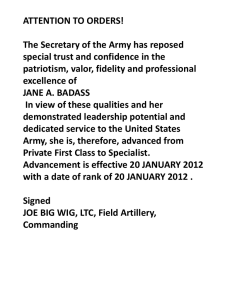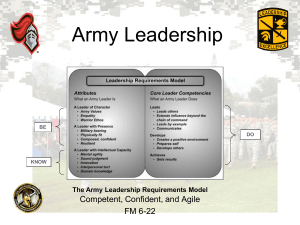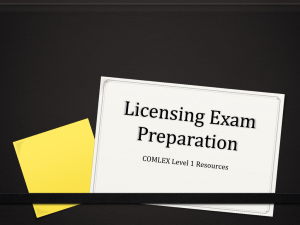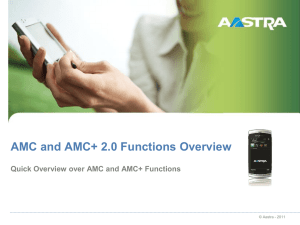File - Army Healthcare careers
advertisement
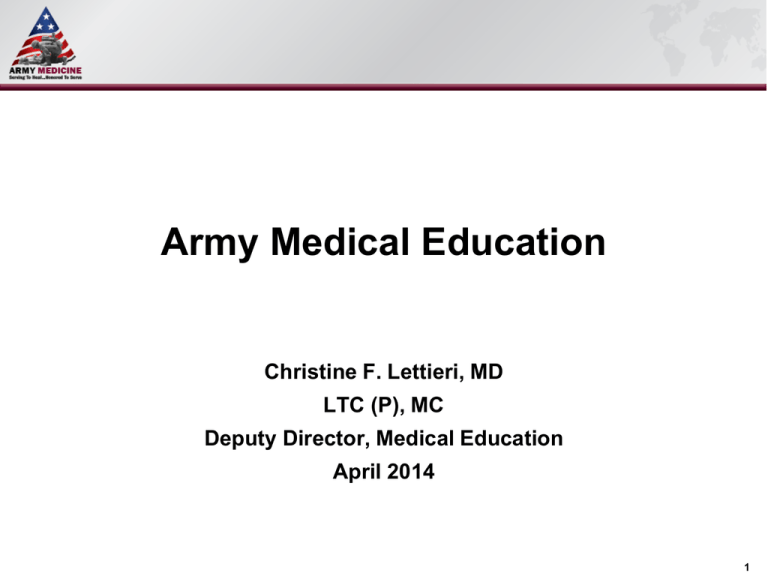
Army Medical Education Christine F. Lettieri, MD LTC (P), MC Deputy Director, Medical Education April 2014 1 Army Health Professions Scholarship Program • 152 medical schools ~280 graduates annually Provides 80% of active duty physicians • • • • • Commissioned as 2LT in US Army Reserve (IRR) 100% tuition paid Required books and fees paid Monthly stipend ($2,157/month) for 10.5 months each year Military pay (about $6000) annually for 45 days Active Duty Training • Obligation is 1 year on active duty for each year of sponsorship in HPSP (2 years minimum) or 4 years if one opts to take Critical Skills Accession Bonus 2 Army Graduate Medical Education • Largest program in the military: 1458 physicians 1341 training in in-house programs; 117 in Army-sponsored civilian training; 28 in educational delay • All Specialties 10 training hospitals 23 primary specialties; 70 residencies; 70 fellowships • Majority of Army physicians train in Army GME programs 29-33% of active duty Medical Corps officers are in GME at any given time • All programs accredited by Accreditation Council for Graduate Medical Education Average GME program cycle length > 6 years under NAS No programs on probation • 94.4% first time board pass rate (civilian 85-89%) 3 Medical Research • In addition to clinical research ongoing in our teaching hospitals, the Army conducts medical research at the following: • The U.S. Army Aeromedical Research Laboratory (USAARL), Fort Rucker, Alabama • • U.S. Army Institute of Surgical Research (USAISR), Fort Sam Houston, Texas • U.S. Army Medical Research Institute of Infectious Diseases (USAMRIID), Fort Detrick, Maryland • U.S. Army Research Institute of Environmental Medicine (USARIEM), Natick, Massachusetts • Walter Reed Army Institute of Research (WRAIR), Forest Glen, Maryland U.S. Army Medical Research Institute of Chemical Defense (USAMRICD), Aberdeen Proving Ground, Maryland U.S. Army Dental Research Detachment U.S. Army Medical Research Detachment Armed Forces Research Institute of Medical Sciences-Thailand (AFRIMS) U.S Army Medical Research Unit- Europe U.S Army Medical Research Unit- Kenya 4 Regional Medical Commands Teaching Hospitals Walter Reed NMMC Eisenhower AMC William Beaumont AMC Womack AMC Martin ACH Madigan AMC Ft. Belvoir Community Hospital Carl R. Darnall AMC Tripler AMC Keller ACH (West Point) Brooke AMC 5 Residencies • • • • • • • • • • • Internal Medicine Family Medicine Emergency Medicine Pediatrics Obstetrics/Gynecology General Surgery Neurosurgery Orthopaedics Urology Otolaryngology Preventive Medicine*/ Occupational Medicine* • • • • • • Dermatology Radiology Radiation Oncology* Anesthesiology Aerospace Medicine* Neurology and Child Neurology • Pathology • Psychiatry • Physical Medicine and Rehabilitation • Ophthalmology * Specialty does not offer continuous contract; must reapply for PGY-2 year. 6 ARMY FIRST YEAR GRADUATE MEDICAL EDUCATION: PGY-1 Programs for the 2014 Selection Board SPECIALT Y SAUSHEC Emergency Medicine X Family Medicine General Surgery X GS Neurosurgery GS Urology X Internal Medicine X Neurology Child Neurology OB-GYN X Orthopaedics X Otolaryngology X Pathology X Pediatrics X Psychiatry T ransitional X Prelim Aerospace Medicine Prelim Anesthesiology X Prelim Dermatology X Prelim Ophthalmology X Prelim Physical Medicine Prelim Preventive Medicine Prelim Radiation Oncology Prelim Radiology(DIAG) X EAMC X X X X MAMC X X X X X X X X X X X X X X X X X X T AMC NCC X X X X X X X X X X X X X X X X X X X X X X X X X X X WBAMC WAMC X CRDAMC X X Martin ACH VA-DoD/Civ. X X X X X X X X X X X X X X X X X X X X X SAUSHEC –Brooke Army Medical Center, Fort Sam Houston, T X/Wilford Hall Medical Center, Lackland AFB, T X/University of T exas, San Antonio, T X NCC –Walter Reed National Military Medical Center, Bethesda, MD/Fort Belvoir Community Hospital, Fort Belvoir, VA /Malcolm Grow Medical Center, Andrews AFB, MD/USUHS 7 Active Duty for Training (ADTs) • Training programs located on website • 1st year - Basic Officer Leader Course (BOLC). If unable to attend then, need to complete before medical school graduation; BOLC should be completed prior to any clinical rotations • 2nd year - School ADT or rotation at Army community hospital • • 3rd and 4th years - Clinical rotations at Army hospitals • Expectation to pass USMLE/COMLEX Parts I and II and CS/PE and attend BOLC prior to graduation Any year - Research rotation at Walter Reed Army Institute of Research, Institute of Surgical Research, Armed Forces Institute of Pathology, Uniformed Services University 8 Deadlines • USMLE Step 1/COMLEX Level 1 Score due to HPSP office by September 15 • USMLE Step 2 CK/COMLEX Level 2 CE and ERAS application Score and ERAS application due October 15 of 4th year • Step 2 CS/Level 2 PE Result due February 15 9 First Year Graduate Medical Education • Mandatory application/participation All participants must apply for training in military residency programs. GME beyond FYGME will always be in military programs or sponsored training (on active duty) in civilian programs. Civilian deferral and participation in the NRMP will be limited and only if authorized by GME office to fill additional training requirements. • FYGME Letter of Instruction (LOI) and Fact Sheet released to 4th year students in July • Application via ERAS and HPSP/FYGME website: ***Potential for change this year with all applications done on Army Medical Education website- see LOI to confirm. • Army Match – computerized match similar to NRMP Students declare specialty and rank all Army programs in that specialty All programs will see all applicants who have identified them as a specialty of choice and will rank all applicants on their order of merit lists (OMLs). Programs are blinded to students’ rankings of programs. Computer sorts and matches using student’s priority and program’s OML Applicants not matching to their specialty of choice match to a transitional year position. Some unfilled positions may be available at post-match rebuttal board. Class of 2014: 85% of applicants selected for desired specialty Active duty service obligation/completion date may change depending on length of residency 10 PGY-1 Categorical Specialties • Emergency Medicine • Family Medicine • General Surgery • Internal Medicine • Neurology • Neurosurgery • OB-GYN • Orthopaedics • Otolaryngology • Pathology • Pediatrics • Prelim Anesthesiology • Prelim Dermatology • Prelim Ophthalmology • Prelim PM&R • Prelim Radiation Oncology • Prelim Radiology • Psychiatry • Urology 11 Applications For PGY-1 Positions: Applicants Per Approved Positions SPECIALTY (Positions Offered) 2010 2011 2012 2013 2014 Emergency Medicine (30) 1.14 1.36 1.38 1.76 1.40 Family Medicine (47) 0.88 1.07 1 0.72 1 General Surgery (27) 1.80 1.65 1.26 1.38 1.41 General Surgery: Neurosurgery (4) 1.5 1.33 1 1.67 1.25 General Surgery: Urology (5) 0.57 0.71 1.29 1.29 1.80 Internal Medicine (59) 0.71 0.66 0.79 0.97 0.66 Neurology (4) 0.50 0.83 0.63 0.67 1 0 1 1 1 2 OB-GYN (19) 0.59 0.83 1.61 1.06 1.28 Orthopaedics (19) 0.89 1.21 1.68 1 0.95 Otolaryngology (7) 1.72 1.33 2.14 0.83 1.43 Pathology (9) 1 1.17 0.89 0.44 0.56 Pediatrics (28) 0.62 0.92 0.79 0.89 1.11 Neurology: Child (1) 12 Applications For PGY-1 Positions: Applicants Per Approved Positions (continued) SPECIALTY (Positions Offered) 2010 2011 2012 2013 2014 1 0 0 2 1 Prelim: Anesthesiology (12) 0.83 1.25 1.09 1.25 1.25 Prelim: Dermatology (7) 1.29 0.71 0.63 1.43 1.71 Prelim: Ophthalmology (7) 0.86 0.43 1.57 1.71 0.86 Prelim: Physical Medicine (3) 1.33 2 3.33 1 3 Prelim: Preventive Medicine (2) 0.50 1 0 1.50 0 Prelim: Radiation Oncology (1) 0 1 0 1 1 Prelim: Radiology (14) 0.87 0.87 0.94 1.14 1.14 Psychiatry (17) 0.87 0.88 0.82 0.35 0.82 2 0 0 0 2 0.13 0.13 0.13 0.35 0.10 Prelim: Aerospace Medicine (1) Psychiatry/Internal Medicine (1) Transitional (40) 13 Board Scores for Matched HPSP/USUHS Students(class of 2014) 2011 national means for matched US students (step 1/step 2) USMLE Step 1 Mean/Min USMLE Step 2 Mean/Min COMLEX Lvl 1 Mean/Min COMLEX Lvl 2 Mean/Min Neurology (225/231) 250/219 236/214 ** ** Psychiatry (216/221) 213/192 221/215 462/430 482/426 Internal Medicine (225/232) 226/193 242/215 509/408 530/400 Family Medicine (214/223) 213/193 229/203 493/408 508/405 General Surgery (224/231) 233/194 247/212 614/539 614/531 Orthopedic Surgery (238/241) 239/197 248/232 639/611 705/686 PM&R (214/220) 229/225 247/243 ** ** Diagnostic Radiology (238/242) 231/205 241/222 513/456 550/494 14 Board Scores for Matched HPSP/USUHS Students(class of 2014) 2011 national means for matched US students USMLE Step 1 Mean/Min USMLE Step 2 Mean/Min COMLEX Lvl 1 Mean/Min COMLEX Lvl 2 Mean/Min OB/GYN (219/229) 232/213 240/419 500/428 544/419 Urology 245/235 244/232 538/451 534/498 Dermatology (242/251) 246/242 251/224 562/549 695/604 Anesthesiology (224/230) 227/204 241/232 536/518 518/494 Pediatrics (219/229) 221/205 220/212 492/438 583/419 Ophthalmology (235/ ** ** ** ** Otolaryngology (240/246) 241/209 252/238 632/621 640/562 (step 1/step 2) 15 Board Scores for Matched HPSP/USUHS Students(class of 2014) 2011 national means for matched US students USMLE Step 1 Mean/Min USMLE Step 2 Mean/Min COMLEX Lvl 1 Mean/Min COMLEX Lvl 2 Mean/Min Pathology (227/230) 226/202 229/223 553/418 614/541 Neurosurgery (239/237) 248/245 256/246 Emergency Medicine (222/230) 225/193 234/206 515/440 569/463 Child Neurology ** ** (step 1/step 2) ** Data restricted to protect student privacy 16 VA-DoD Training Opportunities • Intern year in Army program • Remainder of residency in VAsponsored program Radiology – Georgia Health Sciences University; UT San Antonio Urology – UT San Antonio; Duke University Neurosurgery* – University of Florida; UT San Antonio *Entirety of training in VA-sponsored program 17 2014 Army GMESB Selection Summary Report Fellowship Training Selects Inservice Military Deferred Selects Selects Civilian Sponsored Total Applicants Inservice Select Rate Overall Select Rate Total Selects NonSelects Utilization/ Field 44 0 18 62 27 89 49.44% 69.66% Interns 0 0 0 0 0 0 0% 0% Current Deferred 0 0 0 0 0 0 0% 0% Current Residents 42 0 30 72 71 143 29.37% 50.35% Civilian 1 0 0 0 0 0 0 0 Totals 86 0 48 134 98 232 37.07% 57.76% Senior residents applying for fellowships do almost as well getting selected as staff physicians. Medical Corps Officer Career Progression YEARS 0 Rank 6 CPT BASIC CRS Professional Military Education Additional Training FYGME MAJ CPT CAREER CRS RESIDENCY 30 18 12 COL LTC INTERMEDIATE LEVEL ED SENIOR SVC. COLLEGE FELLOWSHIP CBRNE, SHORT COURSES EXECUTIVE SKILLS COURSE ADV. TRAUMA MANAGEMENT, ADV. TRAUMA LIFE SUPPORT, COMBAT CASUALTY MGT MPH MBA TWI ADVANCED SCIENCE DEGREE DEVELOPMENTAL & UTILIZATION ASSIGNMENTS Typical Assignments Successful Completion of Internship and Residency Utilization Tour Clinician Self Development Successful Completion of Fellowship TOE/TDA Physician Company Commander Clinic OIC Teaching Staff Research Assistant Clinician BN/BDE/DIV Surgeon MEDCOM Staff DCCS MEDCEN Staff MEDDAC Staff Residency Director Product Line Mgr Division Chief Clinician Corps/MACOM Surgeon Commander Joint Assignments DCCS MECEN Staff Deputy Chief Dir Med Ed USUHS Faculty Department Chair Research Area Dir. Continuing Medical Education / Board Recertification License by yr. 2 Board Certification Subspecialty Board Certification 19 Army Medicine Serving the nation since 1775 China 1944 44th MASH, Korea 1954 Radiology residents 1968 Serving to Heal…Honored to Serve 20

